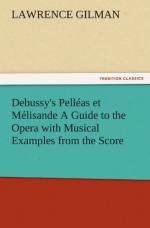What are the more prominent traits of the music of this man who is the product of no school, who has no essential affinities with his contemporaries, who has been accurately characterized as the “tres exceptionnel, tres curieux, tres solitaire M. Claude Debussy”? One is struck, first of all, in savoring his art, by its extreme fluidity, its vagueness of contour, its lack of obvious and definite outline. It is cloudlike, evanescent, impalpable; it passes before the aural vision (so to speak) like a floating and multicolored mist; it is shifting, fugitive, intangible, atmospheric. Its beauty is not the beauty that issues from clear and transparent designs, from a lucid and outspoken style: it is a remote and inexplicable beauty, a beauty shot through with mystery and strangeness, baffling, incalculable. It is unexpected and subtle in accent, wayward and fantastic in rhythm. Harmonically it obeys no known law—consonances, dissonances, are interfused, blended, re-echoed, juxtaposed, without the smallest regard for the rules of tonal relationship established by long tradition. It recognizes no boundaries whatsoever between the different keys; there is constant flux and change, and the same tonality is seldom maintained beyond a single beat of the measure. There are key-signatures, but they strike one as having been put in place as a mere yielding to what M. Debussy doubtless regards indulgently as an amiable and harmless prejudice. His melodic schemes suggest no known model—they conform to patterns which intertwine and melt and are suddenly and surprisingly transformed; they are without punctuation, uncadenced, irregular, unpredictable, indescribably sensitive and supple. There is a marked indifference to the possibilities of contrapuntal effect, a dependence upon a method fundamentally homophonic rather than polyphonic—this music is a rich and shimmering texture of blended chord-groups, rather than a pattern of interlaced melodic strands. One cannot but note the manner in which it abhors and shuns the easily achieved, the facile, the expected. Its colors and designs are rare and far-sought and most heedfully contrived; its eloquence is never unrestrained; and this hatred of the obvious is as plainly sincere as it is passionate and uncompromising; it is not the fastidiousness of a precieux, but of an extravagantly scrupulous and austerely exacting artist.
Here, then, is as anomalous an aesthetic product as one could well imagine. In a day when magnitude of plan and vividness of color, rhetorical emphasis and dynamic brilliancy, are the ideals which preeminently sway our tonal architects, emerges this reticent, half-lit, delicately structured, subtly accented music; which is incorrigibly unrhetorical; which never declaims or insists: an art alembicated, static, severely restrained—for even when it is most harmonically untrammeled, most rhythmically fantastic, one is aware of a quietly inexorable logic, an uncompromising ideal




